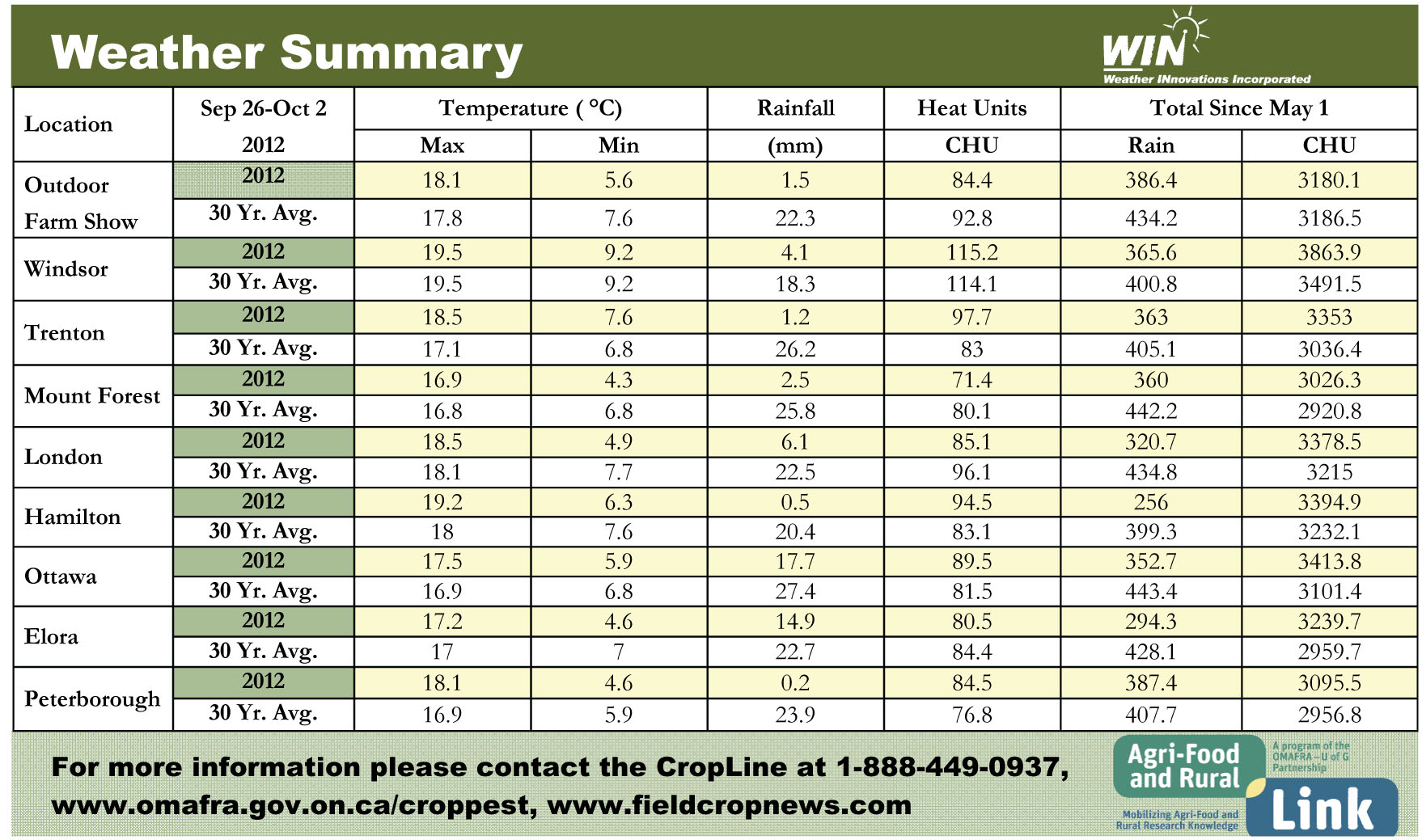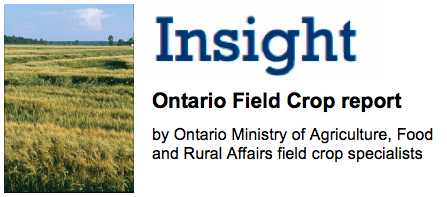Soybeans: Horst Bohner
The last two weeks of steady harvest progress has yielded generally good seed quality and protein levels. Green stems and immature green seed continue to be a challenge in some fields although the majority of the crop has matured normally. Shorter season regions are over 70% harvested with many growers finished while longer season areas range from 30-50% complete. Overall yields continue to be higher than expected with those areas that received timely rains this season seeing yields over 50 bu/ac. A few plots have yielded over 80 bu/ac. Considering the high price of soybeans this will be one of the most profitable soybean production years many growers have experienced.
Considerable acreage was planted as a double crop after winter wheat in 2012. Presently the double crop potential for success ranges from disappointing to outstanding. Some double cropped fields may yield over 40 bu/ac if the frost holds off. Soybeans that reach the R6 growth stage before a killing frost are generally considered salvageable as a grain crop. R6 has been reached when the seed completely fills the cavity within the pod on one of the uppermost four pods. Once R6 is reached, it will take an additional 10-14 days for the crop to reach R7, the beginning of maturity stage when the crop is considered physiological mature and yield losses due to frost are minimal. Presently, most double cropped fields will need a minimum of 14-21 days before they reach R7.
Cereals: Peter Johnson / Scott Banks
Record amounts of wheat were planted in September under perfect conditions with emergence and early growth being excellent. Yield potential of this early planted wheat is outstanding. Planting intentions should easily break 1 million acres. Hard red wheat planting is not keeping pace with soft wheat, due to pricing issues and protein requirement concerns. Winter barley acreage has increased significantly as well despite seed shortages.
As planting moves into October, increase seeding rates into the normal zone: 1.5 million seeds/ac (22 seeds/ft of row) on loams and 1.8M (28) on heavy clays. Phosphorus starter fertilizer is essential to high yield wheat. In furrow applications give the best response and are the most efficient, but if drills are not equipped for in furrow placement, broadcast applications are still economical and highly recommended.
Edible Beans: Brian Hall
White bean harvest is nearly finished while 60-80% of the other bean types are off the field. Yields have varied widely (14- 30 cwt/ac) for most bean types with the better fields often yielding higher than expected. Yield of longer season white bean varieties have been better than short season varieties. Adzuki bean yield, seed size and colour is good. Recent rains have improved harvest moisture and overall quality has been excellent with low disease pressure this season. Harvest of longer season types of beans such as dark red kidneys is just starting with average or above yields. Pre-harvest herbicide treatments are slower acting this year in part due to early shutdown of bean plants. Cool, cloudy weather is also slowing translocation and the speed of desiccation.
Corn: Greg Stewart/Albert Tenuta
The annual provincial survey of mycotoxins in corn was completed during the period of September 18 to 25, 2012 by collecting 171 samples from fields across the province, with multiple hybrids being tested from some fields. Results from the testing showed 85% had DON levels of less than 0.5 PPM; 11 % had DON levels of 0.6 to1.9 PPM; and only 4% exceeded DON levels of 2.0 PPM with no sample being above 3.0 PPM DON. Clearly the incidence of Gibberella and Fusarium ear moulds and DON is minimal this year; perhaps the lowest levels that we have encountered in the past decade. Samples that had slightly elevated DON levels were generally in the southwest part of the province but no specific area could be identified as having a concern for elevated DON.
The concern in the US surrounding another mycotoxin “aflatoxin” has not gone unnoticed in Ontario. In corn, aflatoxin is produced by the fungal pathogen Aspergillus flavus which causes Aspergillusearrot. ThehotdryconditionsacrossmuchofthecorngrowingareaofNorthAmerica have been favourable for Aspergillus ear rot and unfortunately aflatoxin production as well. In Ontario, environmental conditions are often more favorable for Gibberella, Fusarium, Diplodia and other ear rots rather then Aspergillus. Although Aspergillus ear rot and aflatoxin production is rare in Ontario corn, OMAFRA decided, due to the concern and environmental conditions this year, to test for aflatoxin as well. A subset of 26 samples from the total 171 collected was tested for aflatoxin. All 26 samples (100%) were found to have no detectable aflatoxin.
Although the survey indicates that the 2012 Ontario corn crop is distinctly low in ear moulds and vomitoxin, stakeholders are reminded that individual field conditions (environmental, hybrid, tillage, rotation, etc.) are important in ear mould and mycotoxin development. Growers should scout for visual moulds and test for vomitoxin as warranted. See www.fieldcropnews.com/?p=5431
for the full report and map showing distribution of samples and DON levels detected in the survey.




